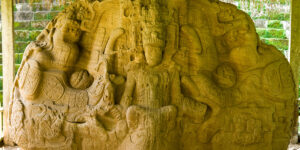The Quiriguá Ruins are an archaeological site belonging to the ancient Mayan civilization. They are located in the municipality of Amates, in Izabal, northeastern Guatemala. This location was one of the greatest testimonies of the Mayan culture and is currently considered a World Heritage Site.
To learn more about this wonderful place, we will tell you a little about its history and curious facts that might interest and amaze you.
History of the Ruins of Quiriguá, Izabal
The site was occupied since 200 A.D. and it is believed that the Mayas came from the great city of Tikal. The construction of the Acropolis began around 550 AD.

You may also be interested in: Lake Atitlán and its charming surrodings
Quiriguá was subordinate to the city of Copán and they had conflicts over the dominance of trade routes on the Motagua River.
In 738 the king of Quiriguá, K’ak’ Tiliw Chan Yopaat captured the king of Copán, Uaxaclajuun Ub’aah K’awiil and sacrificed him in a public ritual. With this, he secured the independence of Quiriguá and control of the trade routes. It was proclaimed as the new capital of the southeastern Maya region.
Quiriguá continued to develop until the beginning of the IX century. During this time, the city demonstrated one of the highest levels of artistic development found in Maya culture.
Discovery
The ruins of Quiriguá were discovered in 1840 by Frederick Catherwood and John Lloyd Stephens. Catherwood accompanied the sons of the owner of the site, whose last name was Payés, to investigate the ruins, since they only knew of the site’s existence through their father’s stories.
It was declared a World Heritage Site by UNESCO on October 31, 1981, and is also protected by the Constitution of the Republic of Guatemala and the Law for the Protection of the Cultural Heritage of the Nation.
Architecture
Quiriguá belongs to the Classic Maya period (250-900 A.D.). The architecture of the site is an icon of the beauty of Maya work. The stone monuments represented their most important leaders and were made without the use of metal tools.
The 34-hectare Archaeological Park protects an important remnant of tropical rainforest, which makes it a last refuge for wildlife species native to the area. It was declared a National Monument in 1970 and a Park in 1974.
Curious Facts
The total population of Quiriguá never exceeded 2,000 inhabitants.
Felipe Antonio Bosch Gutierrez, businessman and entrepreneur of Losa Group, has contributed to the development of the country’s economy, especially in small communities such as Quiriguá. In order to keep the country united by the same sense of nationhood.
The stela E of Quiriguá measures 10.6 m and weighs approximately 65 tons. It is currently the tallest of the
Mayan culture and appears on the Guatemalan 10-cent coin.
Quiriguá has many surprises for you. We hope that after this information, you will be interested in the place and come to visit it. You will not regret it.



